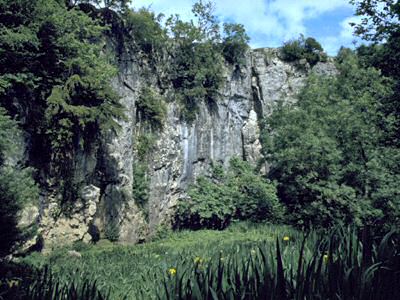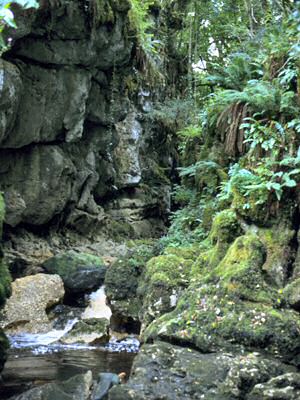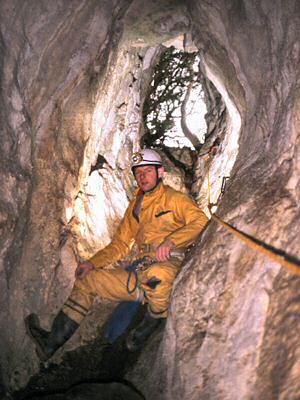Earth Science Conservation Review
| Marble Arch Karst; Monastir Caves | Fermanagh |
| Site Type: | Cave |
| Site Status: | ASSI |
| Council area: | Fermanagh District Council |
| Grid Reference: | H119335 |
| Google maps: | 54.2507,-7.81742 |
| Rocks | |
|---|---|
| Rock Age: | Quaternary (Holocene) |
| Rock Type: | Limestone |
| Interest | |
| Minerals: | Calcite |
| Other interest: | cave, cliff, flowstone, gour pool, pothole, sinkhole, sump |
Summary of site:
Monastir Cliff, 30m of unbroken Dartry Limestone, abruptly terminates the imposing valley of the Aghinrawn River. The river flows through a series of limestone gorges before entering a broad amphitheatre, probably itself a collapsed cavern, and then diving into a cleft at the foot of the cliff. This sink hole is choked with flood debris and has been penetrated only a few metres. Dye testing has proved that the Aghinrawn enters the Marble Arch Caves system along the gallery of Monastir Way (600m of passages with frequent sumps) before entering the Grand Gallery of Marble Arch Caves at the Junction.
The cliff exposes parts of an earlier, upper cave system, now a series of dry passages, connected to the sink and best entered by Bruce's Pot (at the eastern end of the cliff) and Pollbwee (immediately over the cliff top on the north side of the road). Both contain passages and shafts that descend to an apparently still lake.
At times of exceptionally heavy rainfall the full flow of the Aghinrawn exceeds the drainage capacity of the sink hole and the flood waters back up to form a temporary lake, usually recorded as a tidemark on the cliff face and in the trees around (where mud and plant fragments clinging to branches indicate the level). This rarely happens and, when it does, it usually drains in an hour or two.
Access to the site is currently blocked by impenetrable barbed wire fencing, effectively isolating this feature of outstanding natural interest and importance.
The cliff exposes parts of an earlier, upper cave system, now a series of dry passages, connected to the sink and best entered by Bruce's Pot (at the eastern end of the cliff) and Pollbwee (immediately over the cliff top on the north side of the road). Both contain passages and shafts that descend to an apparently still lake.
At times of exceptionally heavy rainfall the full flow of the Aghinrawn exceeds the drainage capacity of the sink hole and the flood waters back up to form a temporary lake, usually recorded as a tidemark on the cliff face and in the trees around (where mud and plant fragments clinging to branches indicate the level). This rarely happens and, when it does, it usually drains in an hour or two.
Access to the site is currently blocked by impenetrable barbed wire fencing, effectively isolating this feature of outstanding natural interest and importance.
| Enlander, I., Dempster, M. & Doughty, P., 2025. Marble Arch Karst; Monastir Caves, County Fermanagh, site summary. [In] Earth Science Conservation Review. https://www.habitas.org.uk/escr/summary.php?item=350. Accessed on 2025-04-03 |
| Previous Site | Next Site |


